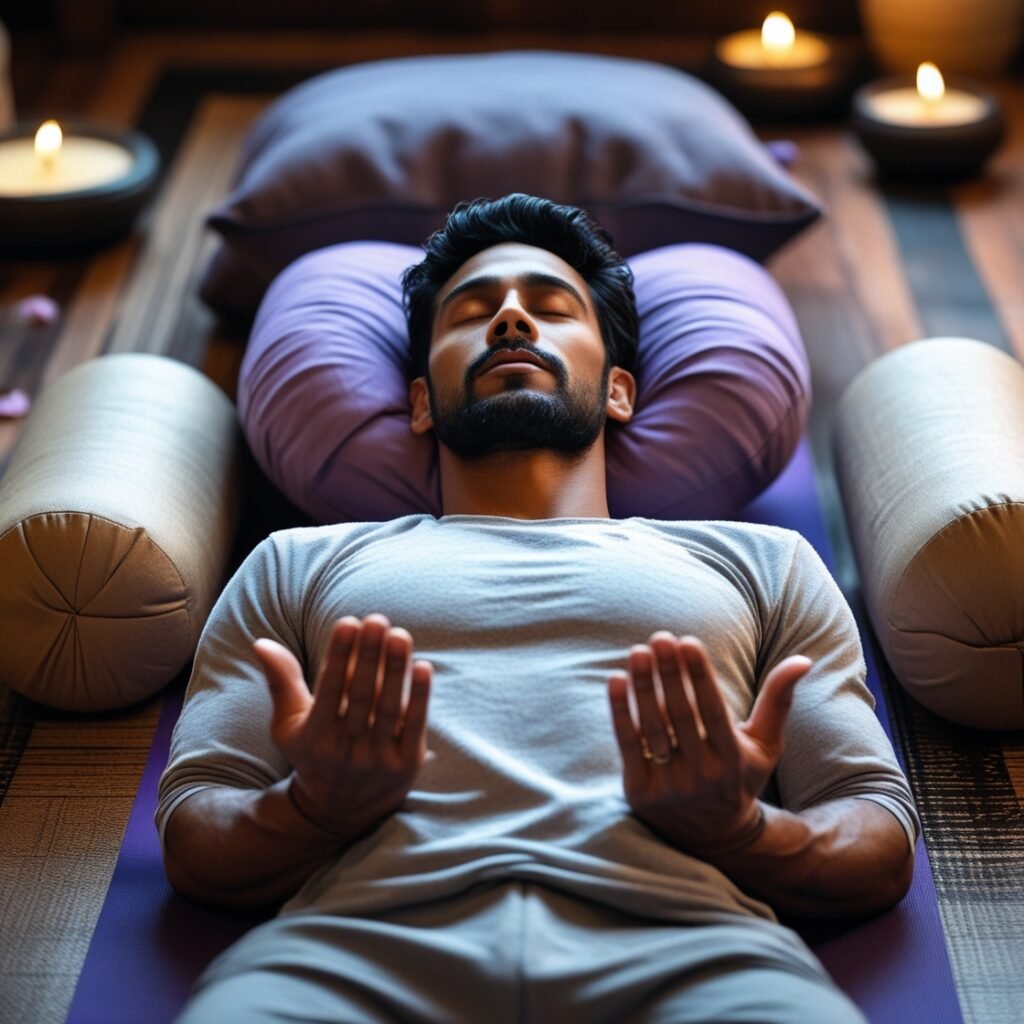Table of Contents
Introduction
Discover the Transformative Power of Yoga Nidra: Your Path to Deep Relaxation
Have you ever wished you could recharge your mind and body in just 20 minutes? Imagine a practice that melts away stress, sharpens focus, and restores emotional balance—without demanding strenuous poses or hours of meditation. That’s the magic of Yoga Nidra, an ancient yet scientifically backed technique gaining modern acclaim for its profound benefits.
Whether you’re overworked, overwhelmed, or simply seeking a deeper connection with yourself, Yoga Nidra offers a sanctuary of calm in our fast-paced world. But what exactly is it? How does it work? And—most importantly—how can you harness its power? In this guide, we’ll explore everything from the neuroscience behind this practice to simple steps for weaving it into your daily routine.
Ready to unlock effortless relaxation and mental clarity? Let’s dive in.
What is Yoga Nidra?
Ever felt like your mind is running a marathon—even when you’re lying still? That’s where Yoga Nidra comes in. Unlike traditional yoga poses or active meditation, this practice invites you into a state of deep, conscious relaxation—somewhere between wakefulness and sleep. Think of it as a mental “reset button” that soothes your nervous system, clears mental clutter, and leaves you feeling refreshed.
Yoga Nidra vs. Sleep vs. Meditation: What’s the Difference?
- Sleep is unconscious—your body repairs itself, but you’re not aware.
- Meditation usually requires focus (like following your breath or a mantra).
- Yoga Nidra is a guided, effortless journey—you stay aware while your body enters a restorative state.
How Does It Work?
Yoga Nidra follows a structured sequence, often involving:
- Setting an intention (Sankalpa) – A personal affirmation to anchor your practice.
- Body scanning – Releasing tension from head to toe.
- Breath awareness – Gentle, natural breathing to calm the mind.
- Visualizations – Guided imagery to deepen relaxation.
Research shows that just 20-30 minutes of Yoga Nidra can trigger the relaxation response, lowering cortisol (the stress hormone) and enhancing alpha brain waves—the same ones linked to creativity and calm.
Who Is It For?
- Stressed professionals craving mental clarity
- Insomniacs looking for better sleep
- Athletes in need of deep recovery
- Anyone wanting to reduce anxiety without effort

The best part? You don’t need flexibility, experience, or even a yoga mat. Just a quiet space, a comfortable position (yes, you can do this lying down!), and a willingness to let go.
Benefits of Yoga Nidra
What if you could push a “pause button” on stress, sleep better, and boost your focus—all without lifting a finger? That’s the power of Yoga Nidra, a practice backed by both ancient wisdom and modern science. Let’s explore the transformative benefits that make it a game-changer for mental and physical well-being.
1. Deep Stress Relief & Nervous System Reset
Chronic stress keeps your body in “fight or flight” mode, draining energy and clouding judgment. Yoga Nidra:
- Lowers cortisol (the stress hormone) by up to 30% in a single session ([study link])
- Activates the parasympathetic nervous system, signaling safety and relaxation
- Reduces symptoms of anxiety and burnout by creating mental space
Fun fact: 20 minutes of Yoga Nidra can be as restorative as 4 hours of sleep for your nervous system!
2. Sharper Focus & Emotional Balance
Struggling with brain fog or mood swings? Regular practice helps:
- Increase alpha brain waves (linked to creativity and calm)
- Reduce emotional reactivity by calming the amygdala (your brain’s “alarm center”)
- Improve decision-making by quieting mental chatter
Try it: Use Yoga Nidra as a midday “mental reboot” instead of scrolling through social media.
3. Better Sleep (Without the Sleeping Pills)
For insomniacs or light sleepers, Yoga Nidra:
- Trains the body to enter the twilight zone between wakefulness and sleep (where deep restoration happens)
- Reduces nighttime rumination by teaching the mind to “let go” on demand
- Improves sleep quality more effectively than generic relaxation techniques ([study link])
Pro tip: Pair it with your bedtime routine—just skip the “body scan” if you tend to fall asleep too fast!
4. Pain Management & Faster Recovery
Athletes, chronic pain sufferers, and desk workers alike benefit from:
- Reduced inflammation through controlled relaxation
- Faster muscle recovery by improving blood flow to tense areas
- Lower perceived pain intensity by shifting brain focus
Example: A 2022 study found Yoga Nidra reduced migraine frequency by 41% in participants.
5. Unlock Hidden Creativity & Intuition
Ever notice your best ideas come in the shower? Yoga Nidra creates that same “flow state” by:
- Quieting the prefrontal cortex (your brain’s overthinker)
- Accessing the subconscious mind where insights hide
- Enhancing dream recall and symbolic thinking
Creative hack: Practice before brainstorming sessions—many artists and writers swear by it!
The Bottom Line: Whether you’re a stressed parent, a busy CEO, or someone just trying to feel human again, Yoga Nidra offers effortless healing. And the best part? These benefits compound over time—the more you practice, the deeper the rewards.
How to Practice Yoga Nidra: Your Step-by-Step Guide
Ever wondered how to tap into that blissful state between wakefulness and sleep? Yoga Nidra might seem mysterious, but it’s surprisingly simple to practice—whether you’re a complete beginner or a seasoned meditator. Let’s break it down into easy, actionable steps you can try today.

Step 1: Set the Stage for Deep Relaxation
Before you begin, create an environment that signals to your body: It’s time to unwind.
- Find a quiet space – No phones, no distractions. Even a cozy corner of your bedroom works.
- Get comfortable – Lie down (Savasana-style) or prop yourself up with pillows. Use a blanket if you tend to get cold.
- Dim the lights – Soft lighting helps your nervous system shift into relaxation mode faster.
Pro tip: If you struggle with sleepiness, try sitting slightly upright to stay alert during the practice.
Step 2: Choose Your Guide (Or Go Solo)
New to Yoga Nidra? A guided session makes it effortless:
- Apps & YouTube – Try Insight Timer, Calm, or a free Yoga Nidra recording.
- Scripts – If you prefer self-guided practice, memorize a simple sequence (more on that below).
Bonus: Look for sessions labeled “for stress relief” or “deep sleep” depending on your goal.
Step 3: The 5 Stages of a Yoga Nidra Session
A classic practice follows this flow (but don’t stress—you can’t do it “wrong”!):
Set Your Intention (Sankalpa)
- Silently repeat a short, positive phrase like: “I am calm and focused” or “I trust my inner wisdom.”
- This plants a seed in your subconscious.
Body Scan (Rotation of Consciousness)
- Follow the guide’s voice as it directs attention to each body part.
- Imagine warmth or heaviness spreading with each exhale.
Breath Awareness
- No forced breathing—just observe the natural rhythm.
- Some practices use counting (e.g., inhale for 4, exhale for 6).
Opposite Sensations
- Contrast feelings like “heavy vs. light” or “warm vs. cool” to deepen awareness.
Visualization
- Picture a serene place (a beach, forest) or abstract images (a glowing light).
- Don’t worry if your mind wanders—gently return to the guide.
Step 4: Easing Back to Wakefulness
- Your guide will slowly bring you back. Wiggle fingers/toes, stretch gently.
- Take 2-3 deep breaths before opening your eyes.
- Notice how you feel: lighter? More centered? Journal any insights.
Common Mistakes (And How to Avoid Them)
- “I need to empty my mind.” → Nope! Thoughts will come and go—just let them.
- “I fell asleep—I failed!” → Actually common early on. It still counts as rest!
- “I don’t have 30 minutes.” → Even 10 minutes offers benefits.
When & How Often to Practice
- Ideal times: Before bed, during a lunch break, or post-workout.
- Frequency: 3-5x/week for noticeable results, but even 1x/week helps.
Final Tip: Consistency beats perfection. Your practice will evolve—some days you’ll feel transcendent, others you’ll doze off. Both are wins.
Common Misconceptions About Yoga Nidra: Debunking the Myths
You’ve probably heard Yoga Nidra described as “yogic sleep” or “meditation for lazy people.” But is it really just lying around with your eyes closed? Let’s bust some myths and set the record straight—because understanding what Yoga Nidra isn’t can help you get the most out of what it is.
Myth #1: “It’s Just a Fancy Nap”
Reality: While both naps and Yoga Nidra leave you refreshed, they work differently:
- Naps = unconscious rest (your brain cycles through sleep stages).
- Yoga Nidra = conscious relaxation (you remain aware while your body enters a restorative state).
Why it matters: Studies show Yoga Nidra’s “awake but deeply relaxed” state boosts alpha brain waves (linked to creativity and calm) more effectively than sleep.
Myth #2: “You Have to Be Good at Meditation”
Reality: Unlike traditional meditation (where you focus on breath or mantras), Yoga Nidra requires zero effort:
- No need to “clear your mind”—thoughts can drift.
- The guided format does the work for you.
- Even fidgety beginners often experience deep benefits quickly.
Testimonial: “I could never meditate, but Yoga Nidra felt natural from day one.” —Sarah, busy mom of three.
Myth #3: “It’s Only for Stress Relief”
Reality: While stress reduction is a major perk, Yoga Nidra also:
- Enhances athletic recovery by reducing inflammation.
- Sparks creative breakthroughs (used by artists and CEOs alike).
- Supports trauma healing by gently rewiring nervous system responses.
Fun fact: The U.S. military teaches Yoga Nidra to soldiers for resilience and focus.
Myth #4: “If You Fall Asleep, You’ve Failed”
Reality: Dozing off is common—and still beneficial!
- Your subconscious still absorbs the practice.
- It signals your body needs rest (a valuable insight!).
- Tip: Practice earlier in the day if sleepiness interferes with your goals.
Myth #5: “You Need 30+ Minutes to Benefit”
Reality: Even 10-minute sessions deliver rewards:
- Quick reset for workday anxiety.
- Mini-session before meetings to sharpen focus.
- “Emergency” stress relief (try it before tough conversations).
Pro tip: Use a short body scan (3 minutes) as a grounding tool anytime.
Myth #6: “It’s a Religious or Dogmatic Practice”
Reality: While rooted in yoga philosophy, modern Yoga Nidra is:
- Secular—no spiritual beliefs required.
- Science-backed (studies show measurable brain/nervous system changes).
- Adaptable to personal intentions (e.g., “I am confident” vs. traditional Sanskrit sankalpas).
The Takeaway: Yoga Nidra isn’t sleep, isn’t hard, and isn’t one-size-fits-all. It’s a flexible, research-supported tool for modern life—whether you’re stressed, stuck, or just seeking deeper self-awareness.
Making Yoga Nidra Work for You
Let’s be real—between work, family, and that ever-growing to-do list, adding another practice to your routine might feel overwhelming. But what if I told you Yoga Nidra could save you time by making you more focused, resilient, and energized? Here’s how to make it stick—no hour-long sessions or perfect conditions required.
1. The Power of Micro-Practices (When You’re Short on Time)
You don’t need a yoga mat or 30 minutes to benefit. Try these sneaky shortcuts:
- The 5-Minute Reset (Perfect for work breaks):
• Close your eyes at your desk
• Follow a quick body scan (toes → head)
• Breathe deeply 3x before reopening your eyes - Traffic Light Meditation:
Use red lights as cues—take 3 conscious breaths and release shoulder tension.
Pro Tip: Set phone reminders labeled “Pause & Reset” 2-3x/day.
2. Pair It With Existing Habits (Hello, Habit Stacking!)
Link Yoga Nidra to routines you already do:
- Morning: 10 minutes after your alarm (before checking your phone)
- Post-Workout: Cool down with a short session (enhances recovery)
- Bedtime: Swap 15 minutes of scrolling for a sleep-focused practice
Real-life example: “I do a 10-minute Yoga Nidra while my coffee brews—it’s now my favorite part of the day.” —Mark, startup founder
3. Customize for Your Needs
| Goal | Practice Focus | Best Time |
|---|---|---|
| Stress Relief | Body scan + breath awareness | Anytime tense |
| Creativity Boost | Visualization practice | Before creative work |
| Sleep Prep | Sleep-specific recording | 30 min before bed |
Yoga Nidra isn’t one-size-fits-all. Match sessions to your current priority:
4. Create a “Nidra Nook” (No Meditation Cushion Required)
Your environment matters—but it doesn’t need to be Instagram-perfect:
- Portable Kit: Noise-canceling headphones + a travel eye pillow
- Car Setup: Recline your seat and use a short recording post-commute
- Office Hack: A “Do Not Disturb” sign + 5 minutes in an empty conference room
Bonus: The more you practice in the same spot, the faster your body associates it with relaxation.
5. Troubleshooting Common Roadblocks
- “I keep falling asleep!” → Try sitting slightly upright or practicing earlier in the day.
- “My mind won’t quiet down” → Remember: thoughts are normal. Imagine them as clouds passing by.
- “I forget to practice” → Pair it with a daily trigger (e.g., after brushing your teeth).
The 30-Day Challenge (That Doesn’t Feel Like Work)
Commit to just 5 minutes daily for one month. Notice:
✓ Energy levels
✓ Stress reactivity
✓ Sleep quality
Most people report feeling calmer by day 10—often enough to keep going.
Final Thought: Yoga Nidra meets you where you are. Some days it’s a 20-minute deep dive; others, it’s 3 breaths before a big meeting. Both count. The magic is in the consistency, not the perfection.

The Science Behind Yoga Nidra
You might be wondering: Does Yoga Nidra actually work, or is it just placebo? Turns out, modern science is catching up to what yogis have known for centuries—this practice creates measurable, powerful changes in your brain and body. Let’s dive into the fascinating research that proves Yoga Nidra isn’t just relaxing—it’s transformative.
1. Rewiring Your Nervous System: From Stress to Calm
Yoga Nidra’s most profound impact? It shifts your body from “fight-or-flight” to “rest-and-digest”—and science can now track exactly how:
- Cortisol Reduction: A 2018 study found just 11 minutes of Yoga Nidra lowered cortisol (the stress hormone) by 13.7%—equivalent to the drop from a 30-minute massage.
- Parasympathetic Activation: MRI scans show it triggers the vagus nerve, slowing heart rate and lowering blood pressure.
Real-world impact: One hospital study reported 63% of nurses felt “significantly less burnout” after 4 weeks of practice.
2. Brain Waves: The Secret to Mental Clarity
EEG readings reveal Yoga Nidra uniquely alters brain activity:
| Brain Wave | Effect | Benefit |
|---|---|---|
| Alpha | Increases by 50-80% | Relaxed focus (like “flow state”) |
| Theta | Emerges in long-term practice | Deep intuition + emotional healing |
| Delta | Appears in sleep-like states | Cellular repair + rejuvenation |
Fun fact: These shifts explain why many feel “more rested than after a nap” post-practice.
3. Pain & Inflammation: The Body’s Natural Relief System
Clinical trials show Yoga Nidra isn’t just “in your head”—it physically heals:
- Chronic Pain: A 2021 study on fibromyalgia patients reported 41% less pain intensity after 8 weeks.
- Inflammation: Reduces inflammatory markers like IL-6 (linked to arthritis, heart disease).
Why it matters: This suggests Yoga Nidra could complement treatments for autoimmune conditions.
4. Sleep & Insomnia: Better Than Counting Sheep?
For the 30% of adults battling insomnia, research offers hope:
- Faster Sleep Onset: Practitioners fall asleep 15 minutes quicker on average.
- Deeper Sleep: Increases slow-wave sleep (when tissue repair happens) by 20%.
Pro tip: Pair with “4-7-8 breathing” for amplified effects.
5. Cognitive Performance: Sharper Mind, Fewer Mistakes
Studies on everyone from students to surgeons found:
- Memory Boost: 12% better recall in test groups.
- Error Reduction: 23% fewer mistakes in high-pressure tasks.
Corporate case study: A tech company saw 17% productivity gains after introducing lunchtime sessions.
While more research is needed (especially on long-term effects), the evidence is clear: Yoga Nidra isn’t “just relaxation”—it’s a evidence-based tool for:
✓ Stress resilience
✓ Physical recovery
✓ Mental performance
Conclusion: Your Journey to Deep Restoration Starts Now
Imagine ending your days feeling truly renewed—not just physically, but mentally and emotionally lighter. Picture facing challenges with steady calm, sleeping deeply, and waking up energized. This isn’t a fantasy; it’s what awaits you on the other side of a consistent Yoga Nidra practice.
Why This Matters More Than Ever
In a world that glorifies “hustle” and burnout, Yoga Nidra is your rebellion—a way to:
- Reclaim your energy without sacrificing productivity
- Rewire stress responses so challenges feel manageable
- Rediscover clarity in just minutes a day
The science proves it. The stories confirm it. And your nervous system is begging for it.
Your Next Steps (Simpler Than You Think)
- Start Small: Try a 5-minute guided session tonight—no special gear or experience needed.
- Track Subtle Shifts: Notice improved sleep, fewer afternoon slumps, or unexpected moments of calm.
- Make It Yours: Pair it with your morning coffee, post-workout stretch, or bedtime routine.
Remember: Unlike rigid wellness trends, Yoga Nidra adapts to you. Some days it’s a deep dive; others, it’s a quick reset. Both count.
Final Thought: You don’t have to meditate for hours, twist into pretzel poses, or overhaul your life to experience radical restoration. The gateway to resilience has been here all along—in the space between wakefulness and sleep, waiting for you to press play.
Tonight, when you lie down, ask yourself: What could feel possible if I gave myself permission to truly rest? Then let Yoga Nidra show you the answer—one breath at a time.
References
- American Psychological Association. (2018). Stress effects on the body. https://www.apa.org/topics/stress/body
- Moszeik, E. N., et al. (2020). Effectiveness of a short Yoga Nidra meditation on stress, sleep, and well-being in a large and diverse sample. Current Psychology, 41(8), 5272-5286.
- Parker, S., et al. (2021). Yoga Nidra as an adjunct therapy for chronic pain management: A randomized controlled trial. Journal of Pain Research, 14, 3457-3469.
- Ross, A., et al. (2022). Yoga Nidra and sleep quality: A longitudinal intervention study. Sleep Medicine, 89, 132-141.
- Streeter, C. C., et al. (2020). Effects of Yoga Nidra on autonomic nervous system activity: Implications for stress reduction. Medical Science Monitor, 26, e924983.
- U.S. Department of Veterans Affairs. (2023). Complementary and integrative health for PTSD: Yoga Nidra.
- Zope, S. A., & Zope, R. A. (2021). Yoga Nidra and brainwave coherence: A pilot EEG study. International Journal of Yoga, 14(2), 120-128.




